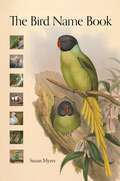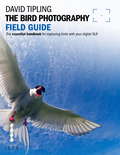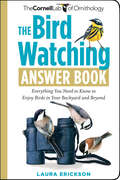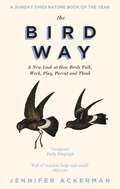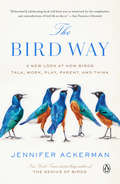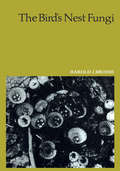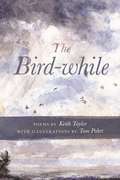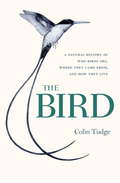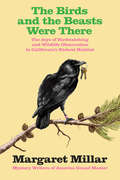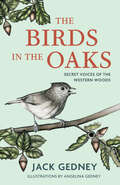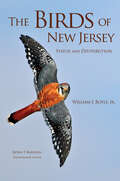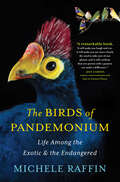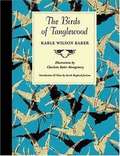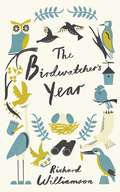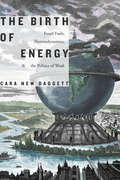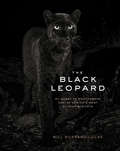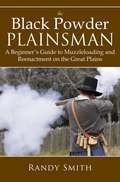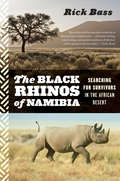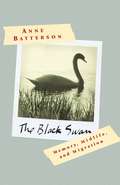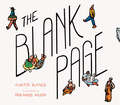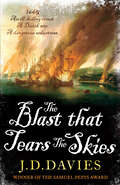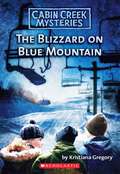- Table View
- List View
The Bird Name Book: A History of English Bird Names
by Susan MyersA marvelously illustrated A-to-Z compendium of bird names from around the globeThe Bird Name Book is an alphabetical reference book on the origins and meanings of common group bird names, from “accentor” to “zeledonia.” A cornucopia of engaging facts and anecdotes, this superbly researched compendium presents a wealth of incisive entries alongside stunning photos by the author and beautiful historic prints and watercolors. Myers provides brief biographies of prominent figures in ornithology—such as John Gould, John Latham, Alfred Newton, and Robert Ridgway—and goes on to describe the etymological history of every common group bird name found in standardized English. She interweaves the stories behind the names with quotes from publications dating back to the 1400s, illuminating the shared evolution of language and our relationships with birds, and rooting the names in the history of ornithological discovery.Whether you are a well-traveled birder or have ever wondered how the birds in your backyard got their names, The Bird Name Book is an ideal companion.
The Bird Photography Field Guide: The Essential Handbook For Capturing Birds With Your Digital Slr (Field Guide Ser.)
by David TiplingThis is a comprehensive and practical guide to photographing birds living in a wide variety of landscapes and climates. Helpful maps and site information, along with travel advice and technical tips, ensure this book is a 'must have' for all bird photographers - and bird enthusiasts as well.
The Bird Photography Field Guide: The Essential Handbook For Capturing Birds With Your Digital Slr (Field Guide Ser.)
by David TiplingA specialist title aimed at bird watchers, this handy book contains all the expertise you need to make your bird-watching trip into a rewarding photo session: there is copious advice on equipment, technique and field craft, and a wealth of wonderful photos to inspire you. Finally, a section on the digital darkroom will help you turn your shots into perfect prints.
The Bird Watching Answer Book: Everything You Need to Know to Enjoy Birds in Your Backyard and Beyond
by Laura EricksonLearn the how’s and why’s of bird behavior, from flirtatious mating practices and gorgeous birdsong to flying south for the winter. In this lively reference book, Laura Erickson addresses hundreds of real-life questions sent in to the Cornell Lab of Ornithology, the world’s foremost authority on birds. <P><P> With expert advice on bird watching techniques and equipment, feeding and housing birds, protecting habitats, and much more, Erickson guides you through the intricacies of the avian world with a contagious passion for our feathered friends.
The Bird Way: A New Look at How Birds Talk, Work, Play, Parent, and Think
by Jennifer Ackerman'A celebration of the dizzying variety of bird life and behaviour, one that will enthral birders and non-birders alike' The ObserverFrom the New York Times bestselling author of The Genius of Birds, a radical investigation into the bird way of being, and the recent scientific research that is dramatically shifting our understanding of birds. 'There is the mammal way and there is the bird way.' This is one scientist's pithy distinction between mammal brains and bird brains: two ways to make a highly intelligent mind. But lately, scientists have taken a new look at bird behaviours they've previously dismissed as anomalies. What they're finding is upending the traditional view of how birds live, how they communicate, forage, court, survive. They're also revealing the remarkable intelligence underlying these activities, abilities we once considered uniquely our own - deception, manipulation, kidnapping, infanticide, but also, ingenious communication between species, collaboration, altruism and play. Some of these behaviours are biological conundrums that seem to push the edges of - well - birdness: A mother bird that kills her own infant sons, and another that selflessly tends to the young of other birds. Young birds that devote themselves to feeding their siblings and others so competitive they'll stab their nestmates to death. Birds that give gifts and birds that steal, birds that dance or drum, that paint their creations or paint themselves, and birds that summon playmates with a special call - and may hold the secret to our own penchant for playfulness and the evolution of laughter. Drawing on personal observations, the latest science, and her bird-related travel around the world, Ackerman shows there is clearly no single bird way of being. In every respect, in plumage, form, song, flight, lifestyle, niche, and behaviour, birds vary. It's what we love about them.'Biologist and bestselling author Jennifer Ackerman knows what she's talking about . . . Chapter by meatily evidence-based chapter, she lays out the assumptions that underpin our understanding of birds - and then pecks them apart . . . Her knack for catching the personalities of different species in gorgeous, playful prose further collapses comfortable barriers between the human and the birdlike . . . More than it is a book about birds - and it is, indisputably, a book about birds - The Bird Way is about diversity and tolerance. A little bird told me that's just what we need in 2020' Daily Telegraph, ***** (Five Stars)'Jennifer Ackerman is not a field researcher, but with her eye for a great story she converts the scientific findings of others into popular books. The real joy of her book is its close attention to some of the specialists of the region . . . Ackerman is also alive to the humour at play in field research' Mark Cocker, The Spectator
The Bird Way: A New Look at How Birds Talk, Work, Play, Parent, and Think
by Jennifer AckermanFrom the New York Times bestselling author of The Genius of Birds, a radical investigation into the bird way of being, and the recent scientific research that is dramatically shifting our understanding of birds -- how they live and how they think.&“There is the mammal way and there is the bird way.&” But the bird way is much more than a unique pattern of brain wiring, and lately, scientists have taken a new look at bird behaviors they have, for years, dismissed as anomalies or mysteries –– What they are finding is upending the traditional view of how birds conduct their lives, how they communicate, forage, court, breed, survive. They are also revealing the remarkable intelligence underlying these activities, abilities we once considered uniquely our own: deception, manipulation, cheating, kidnapping, infanticide, but also ingenious communication between species, cooperation, collaboration, altruism, culture, and play. Some of these extraordinary behaviors are biological conundrums that seem to push the edges of, well, birdness: a mother bird that kills her own infant sons, and another that selflessly tends to the young of other birds as if they were her own; a bird that collaborates in an extraordinary way with one species—ours—but parasitizes another in gruesome fashion; birds that give gifts and birds that steal; birds that dance or drum, that paint their creations or paint themselves; birds that build walls of sound to keep out intruders and birds that summon playmates with a special call—and may hold the secret to our own penchant for playfulness and the evolution of laughter. Drawing on personal observations, the latest science, and her bird-related travel around the world, from the tropical rainforests of eastern Australia and the remote woodlands of northern Japan, to the rolling hills of lower Austria and the islands of Alaska&’s Kachemak Bay, Jennifer Ackerman shows there is clearly no single bird way of being. In every respect, in plumage, form, song, flight, lifestyle, niche, and behavior, birds vary. It is what we love about them. As E.O Wilson once said, when you have seen one bird, you have not seen them all.
The Bird's Nest Fungi
by Harold J. BrodieThe intriguing Bird's Nest Fungi (Nidulariaceae) of forest, meadow, and garden have been familiar to botanists since 1601, but only relatively recently has the significance of their peculiar form been realized. Dr Brodie traces the long controversy that arose when Bird's Nest Fungi were first classified as seed plants because of the numerous seed-like bodies contained in their small cup-shaped fruit bodies. The 'seeds' are now known to contain spores like those of other fungi such as puffballs, to which the Nidulariaceae are related. Present-day research has shown that certain Bird's Nest Fungi produce chemicals having previously unrecognized molecular structure. Between these milestones Dr Brodie reveals the solution to the mystery of the dispersal of the 'eggs' from the 'bird's nest': the fruit bodies are splash guns from which the reproductive spores are ejected by the force of falling raindrops. This explanation of the phenomenon is supported by copious observations and hitherto unpublished experiments.All known species of Nidulariaceae, including many only recently recognized, are described in this volume. All aspects of growth, structure, development, and life-cycle of these fungi, both in nature and in laboratory culture, are reported in a modern, comprehensive treatment of a subject which is of interest not only to mycologists but to amateur naturalists as well.
The Bird-while (Made in Michigan Writers Series)
by Keith Taylor“A Bird-while. In a natural chronometer, a Bird-while may be admitted as one of the metres, since the space most of the wild birds will allow you to make your observations on them when they alight near you in the woods, is a pretty equal and familiar measure” (Ralph Waldo Emerson’s Journal, 1838). Without becoming didactic or pedantic about the spiritual metaphor hidden in the concept of the “bird-while,” Keith Taylor’s collection evokes certain Eastern meditative poets who often wrote in an aphoristic style of the spirit or the mind mirroring specific aspects of the natural world. The Bird-while is a collection of forty-nine poems that meditate on the nature—both human and non-human—that surrounds us daily. Taylor is in the company of naturalist poets such as Gary Snyder and Mary Oliver—poets who often drew from an Emersonian sensibility to create art that awakens the mind to its corresponding truths in the natural world. The book ranges from the longer poem to the eight line, unrhymed stanza similar to that of the T'ang poet Han-Shan. And without section breaks to reinforce the passing of time, the collection creates greater fluidity of movement from one poem to the next, as if there is no beginning or end, only an eternal moment that is suspended on the page. Tom Pohrt’s original illustrations are scattered throughout the text, adding a stunning visual element to the already vivid language. The book moves from the author’s travel accounts to the destruction of the natural world, even species extinction, to more hopeful poems of survival and the return of wildness. The natural rhythm is at times marred by the disturbances of the twenty-first century that come blaring into these meditations, as when a National Guard jet rumbles over the treeline upsetting a hummingbird, and yet, even the hummingbird is able to regain its balance and continue as before. At its core, Taylor’s collection is a reminder of Emerson’s idea that natural facts are symbols of spiritual facts. These well-crafted poems will be easily accessible to any literary audience, with a more particular attraction to readers of contemporary poetry sensitive to the marriage of an Eastern sensibility with contemporary American settings and scenes.
The Bird: A Natural History of Who Birds Are, Where They Came From, and How They Live
by Colin TudgeOriginally published: Consider the birds: who they are and what they do. London: Allen Lane, 2008.
The Birds and the Beasts Were There: The Joys of Birdwatching and Wildlife Observation in California's Richest Habitat
by Margaret MillarSanta Barbara in the 1960s was home to two of the 20th century’s most important mystery writers, Margaret Millar and her husband, Ken (Ross Macdonald). It was also home to nearly 400 species of bird. This is the charming story of Ken and Maggie’s quest to see them all. The addiction that is birdwatching comes to vivid life in Margaret Millar’s delightful memoir of her early days as a naturalist. Part autobiography and part birdwatcher’s journal, it is a moving elegy to a bygone place and time. Millar brings her meticulous plotting and no small amount of suspense to these charming stories of a belligerent brown towhee named Houdunit, a larcenous raven called Melanie, and a rat who carefully ferments his grapes before eating them, to name only a few. Ornithology was a passion for both Ken and Maggie and they devoted their lives to it with the same keen sense of detail and, in the case of Margaret, storytelling vigor as they brought to their writing. In this book, the only memoir she wrote, Millar takes us on her journey from curious amateur to obsessive completionist. It is a phenomenon nearly any birding enthusiast will recognize. Ken and Margaret Millar were founding members of the Santa Barbara Audubon Society.
The Birds in the Oaks: Secret Voices of the Western Woods
by Jack GedneyThe first book on the birds of California's oaks, from our most lyrical and observant wanderer of the woods.With charm and delight, The Birds in the Oaks introduces us to the birds who burrow, forage, and soar among California's keystone trees. The mighty oak hosts a multitude of avian denizens—from canopy hoppers to ground nesters to short-billed surface pluckers—who rely on the trees' well-stocked pantry of acorns, insects, and flowers for sustenance and shelter. Spunky kinglets, crimson-eyed towhees, cuddle-craving bushtits, intrepid nuthatches, and impudent wrens are among the many memorable cast members in this pageant of oak-allied birds.Jack Gedney lyrically conveys the beautiful, comic, and endearing qualities of over fifteen bird species, each profile paired with an illustration by Angelina Gedney. His bird-filled tales of adaptation, ingenuity, and sheer persistence also bring to light the warp and weft of cross-species interdependence. The Birds in the Oaks reveals to us the utter joy of birds, the superabundant world of the oaks, and the innumerable interconnections these living beings create.
The Birds of New Jersey: Status and Distribution
by William J. BoyleNew Jersey provides some of the most varied and exciting birding in North America, and more than 450 species have been recorded in the state. Yet there has been no comprehensive and readily available guide to the status and distribution of all these species--until now. The Birds of New Jersey is the most up-to-date and succinct guide for the birds of New Jersey and includes all species known to the state from historical times to the present. Featuring over 200 color photos of rarities and regular species, this book authoritatively provides individual entries that include a summary of status and seasonal distribution, and comments on changes over time. Detailed color-coded maps accompany species accounts, and for species recorded five or fewer times, dates and locations of each record are noted. The introduction examines the state's geography, the history of bird records, and background information to species accounts, and the extensive bibliography guides birders to original sources used in the book. This is the essential resource for birders, ornithologists, and nature enthusiasts interested in the birds of New Jersey and the greater surrounding region. Most up-to-date status and distribution guide for New Jersey and surrounding region All bird species known to the state Species accounts describe the preferred habitat and abundance of species Range maps in color detail seasonal distribution For migratory birds, spring and fall migration times indicated More than 200 color photographs of rare and common species
The Birds of Pandemonium: Life Among The Exotic And The Endangered
by Michele Raffin“Michele Raffin has made an important contribution to saving endangered birds, and her book is a fascinating and rarely seen glimpse behind the scenes. The joy she gets from her close relationships with these amazing animals and her outsized commitment to them comes through loud and clear in this engaging and joyful book.” —Dominick Dorsa, Curator of Birds, San Francisco ZooEach morning at first light, Michele Raffin awakens to the bewitching music that heralds another day at Pandemonium Aviaries—a symphony that swells from the most vocal of over 350 avian throats representing over 40 species. “It knocks me out, every day,” she admits. Pandemonium Aviaries is a conservation organization dedicated to saving and breeding birds at the edge of extinction, including some of the largest populations of rare species in the world. And their behavior is even more fascinating than their glorious plumage or their songs. They fall in love, they mourn, they rejoice, they sacrifice, they have a sense of humor, they feel jealous, they invent, plot, cope, and sometimes they murder each other. As Raffin says, “They teach us volumes about the interrelationships of humans and animals.”Their stories make up the heart of this book. There’s Sweetie, a tiny quail with an outsize personality; the inspiring Oscar, a Lady Gouldian finch who can’t fly but finds a way to reach the highest perches of his aviary to roost. The ecstatic reunion of a disabled Victoria crowned pigeon, Wing, and her brother, Coffee, is as wondrous as the silent kinship that develops between Amadeus, a one-legged turaco, and an autistic young visitor. Ultimately, The Birds of Pandemonium is about one woman’s crusade to save precious lives, bird by bird, and offers insights into how following a passion can transform not only oneself but also the world.“Delightful . . . full of wonderful accounts of bird behavior, demonstrating caring, learning, sociability, adaptability, and a will to live. Its appeal is ageless, her descriptions riveting, and her devotion to the birds remarkable.” —Joanna Burger, author of The Parrot Who Owns Me: The Story of a Relationship“A remarkable book. Reading about the birds of Pandemonium will make you laugh and cry; it will make you see more clearly the need to take care of our planet; and it will confirm that one person with a passion can make a difference.” —Jeff Corwin, nature conservationist and host, Animal Planet“The Birds of Pandemonium touched me deeply . . . This book is about reconnecting with the nature of birds, and the nature of ourselves.” —Jon Young, author of What the Robin Knows
The Birds of Tanglewood
by Karle Wilson Baker Sarah Ragland Jackson Charlotte Baker MontgomeryIn the intimate language of one who watched birds daily, Karle Wilson Baker brought readers face to face with the wonders of the East Texas woods in the 1930s. She wrote about tiny warblers, industrious chickadees, and purple finches; the aery trills and tantalizing color flashes of the hummingbirds; the bell tones of the woodthrush; the daily visits and rare drop-ins of the prolific bird life of the region. In a daily diary she kept throughout her life, Baker recorded her observations of the many birds that lived in the heavily wooded setting of her Nacogdoches home, called Tanglewood. When her family moved from the house, she collected her essays on bird life into this volume, illustrated by her daughter Charlotte and published in 1930. Her little classic speaks with the voice of her times to readers today who enjoy their avian companions.
The Birdwatcher’s Year
by Richard WilliamsonThis handbook is bursting with tips, facts and folklore to guide you through the birdwatching year. Find out how to identify birds by sight or song; learn about their behaviour, habitats, and breeding and migration habits; and discover how to encourage birds into your garden. Includes handy pages for making your own notes each month.
The Birth of Energy: Fossil Fuels, Thermodynamics, and the Politics of Work (Elements)
by Cara New DaggettIn The Birth of Energy Cara New Daggett traces the genealogy of contemporary notions of energy back to the nineteenth-century science of thermodynamics to challenge the underlying logic that informs today's uses of energy. These early resource-based concepts of power first emerged during the Industrial Revolution and were tightly bound to Western capitalist domination and the politics of industrialized work. As Daggett shows, thermodynamics was deployed as an imperial science to govern fossil fuel use, labor, and colonial expansion, in part through a hierarchical ordering of humans and nonhumans. By systematically excavating the historical connection between energy and work, Daggett argues that only by transforming the politics of work—most notably, the veneration of waged work—will we be able to confront the Anthropocene's energy problem. Substituting one source of energy for another will not ensure a habitable planet; rather, the concepts of energy and work themselves must be decoupled.
The Black Fawn
by Jim KjelgaardA heartbreakingly warm and moving story of a young orphaned boy, sold out of an orphanage to work on a farm, and of his relationship with an equally orphaned black fawn that he one day stumbles upon in the forest. Will their bond survive the many problems that adults pose in their way, such as hunting? A tale with a classic, timeless and universal feel and message to it.
The Black Leopard: My Quest to Photograph One of Africa's Most Elusive Big Cats
by Will Burrard-LucasThis inspiring book tells the story of a photographer's journey to find the mysterious black leopard.There are few creatures as gorgeous and elusive as the black leopard. In Africa, these magnificent cats are so rare as to be the stuff of legend. Will Burrard-Lucas's love for leopards began during his childhood in Tanzania and propelled him into a career as a wildlife photographer. In his quest to create intimate portraits of animals, he developed innovative technology, including a remotely controlled camera buggy and a high quality camera trap system for photographing nocturnal creatures. Then, one day in 2018, he heard about sightings of a young African black leopard in Kenya and with the help of people from the local community, he succeeded in capturing a series of high-quality photographs of the elusive cat. In this compelling and visually stunning book, Burrard-Lucas tells his story of creativity, entrepreneurship, and passion for wild animals, alongside awe-inspiring images of lions, elephants, and the black leopard itself.• STAR WILDLIFE PHOTOGRAPHER: Will Burrard-Lucas's passion for nature and expertise in camera technology have earned him coverage from National Geographic, The New York Times, and the BBC—and over 1 million fans enjoy his breathtaking work online.• NATURE'S HIDDEN WONDERS: Black leopards are individual animals in whom a gene mutation results in excess melanin and an elegant black coat. Most are found in Southeast Asia, where lush vegetation offers them camouflage. In the semiarid shrub lands of Africa, black leopards are extraordinarily rare. Burrard-Lucas's images—showing these beautiful creatures prowling their territory under cover of night—are vivid reminders of nature's hidden wonders.• INCREDIBLE STORY: This is an adventure story that takes place in remote and wild corners of Africa. It reveals Burrard-Lucas's devotion, vision, and innovation that led to him capturing photos that are not only incredibly rare, but also breathtakingly beautiful.Perfect for:• Aspiring and professional photographers• Photography buffs• Nature and animal lovers• Big cat enthusiasts• Conservationists• National Geographic readers• Fans of memoir and adventure stories• Travelers to Eastern and Southern Africa
The Black Powder Plainsman: A Beginner's Guide to Muzzleloading and Reenactment on the Great Plains
by Randy SmithThe Black Powder Plainsman provides a wealth of information on muzzleloading and the history of the Plainsmen. The author explores the lives and roles of women, Plainsmen relations with the Native Americans, and the current status of the hobby of muzzleloading, along with many other topics. He also shares advice on how to get involved in historical reenactments and how to preserve the values of the early Plainsmen. Hunting techniques with muzzleloading rifles are also explored.
The Black Rhinos of Namibia
by Rick BassFrom one of our most gifted writers on the natural world comes a stunning exploration of a unique landscape and the improbable and endangered animal that makes its home there.Rick Bass first made a name for himself as a writer and seeker of rare, iconic animals, including the grizzlies and wolves of the American West. Now he's off on a new, far-flung adventure in the Namib of southwest Africa on the trail of another fascinating, vulnerable species. The black rhino is a three-thousand-pound, squinty-eyed giant that sports three-foot-long dagger horns, lives off poisonous plants, and goes for days without water.Human intervention and cutting-edge conservation saved the rhinos--for now--from the brink of extinction brought on by poaching and war. Against the backdrop of one of the most ancient and harshest terrains on earth, Bass, with his characteristic insight and grace, probes the complex relationship between humans and nature and meditates on our role as both destroyer and savior.In the tradition of Peter Matthiessen's The Tree Where Man Was Born, Bass captures a haunting slice of Africa, especially of the "black" rhinos that glow ghostly white in the gleaming sun.
The Black Swan
by Anne BattersonSet against a spontaneous cross-country road trip following the migrating birds, this passionate, lyrical memoir is one woman's reflections on midlife, her important personal relationships, her kaleidoscopic past, and her uncertain future. To fifty-six-year-old Anne Batterson, a woman whose life has been filled with adventure -- as a commercial pilot, an international skydiving champion, a trekking guide in Nepal -- her husband's decision to retire felt like a death sentence. Yearning for some way to reconcile herself to the future that was rapidly unfolding before her, she packed up her VW camper and hit the road with maps, bird guides, and little else except the desire to follow the fall migration and the bone-deep hunch that birds had something important to teach her. In this beautifully written narrative of that extraordinary trip, Batterson writes movingly not only about her experiences with the birds but also about the people she loves, has lost, and connects with along the way. Events from the present trigger vivid stories from the past. In the chapter "The Journey Within the Journey," a long, lonely night in a deserted campground in Virginia conjures up the ghosts of a desperate solo road trip she made when she was twenty-one. A towering cumulus cloud in Illinois brings back a breathtaking free fall into a similar cloud in "My Time as a Bird. " An encounter with a great blue heron summons a compelling account of her mother's last afternoon in the world. "Bears in the Woods" describes a run-in with twoDeliverance-type men in West Virginia, which brings back the murder of a dear friend in the woods of Connecticut. By the end of the journey, the ghosts of the past, like the author herself, have become part of a more fluid, more spiritual reality -- wild and spare and elegant and timeless -- one that is always out there, "quickening on the far side of reality. "A unique mix of memoir and nature writing,The Black Swanis a charming story of a woman's odyssey.
The Blackbird's Song & Other Wonders of Nature: A year-round guide to connecting with the natural world
by Miles Richardson'A wonderful "rough guide" to the planet we live on... Read it and pass it on as a gift of love from you to those around you so they can learn to feel comfortable in their own skins and ultimately, be happy.' ― Sir Tim Smit, The Eden Project An almanac, focused on reconnecting with the great outdoors for the benefit of both us and nature.Each month in The Blackbird's Song, Miles Richardson delves into the science and mythology behind our relationship with nature, exploring everything from our kinship with plants to the way in which nature influences our moods.Along the way, he offers a range of activities to help us access the benefits of the natural world.Whether it be 'joy-watching' birds, rediscovering wonder, foraging for Christmas crafts or going on an urban safari, this book contains all the tools and inspiration you need to unlock the transformative power of nature and find real meaning in your life.
The Blank Page: How a Piece of Paper Connects to Everything
by Alberto BlancoIs a blank page really blank? Beloved poet Alberto Blanco pulls back the curtain and illuminates all of the elements hidden in a single piece of paper: the tree it was made from, the rain and sun that allowed the tree to grow, and the people that created it. An enlightening read for readers young and old, it soon becomes clear that a blank page contains the whole cosmos.In The Blank Page, world-renowned Mexican poet Alberto Blanco inspires children and adults to keep looking deeper, to never take things at face value. Charming illustrations by Rob Moss Wilson portray a world that slowly comes to life in a single sheet of paper: first the tree, then the forest, then the people are discovered, revealing the whole interrelated ecosystem of our world. As Blanco says: "Where nothing happens, there is a miracle we are not seeing."
The Blast that Tears the Skies (The Matthew Quinton Journals)
by J. D. DaviesPart of an &“excellent series&” of nautical sagas, a Royal Navy captain commands a challenging warship as England enters the Anglo-Dutch wars&” (Publishers Weekly). 1665: plague stalks the streets of London, the country is at war, and conspiracies against King Charles II are rife. When given command of a vast and ancient Man-of-War, Captain Matthew Quinton finds himself thrust unexpectedly into the midst of the deadliest of these plots . . . Grappling with scheming ministers and a rebellious crew, Quinton must sail his &“cursed&” ship against the might of the Dutch fleet. Embroiled in the epic Battle of Lowestoft, one of the greatest conflicts fought at sea, he must pull his crew together, and fight for his life. But in a shattering conclusion, he must face a terrible family secret that will push him to the limits . . .The Blast that Tears the Skies is the riveting third book in the Matthew Quinton Journals nautical adventures. Praise for the writing of J. D. Davies: &“Hornblower, Aubrey and Quinton—a pantheon of the best adventures at sea!&” —Conn Iggulden, #1 New York Times–bestselling author of The Conqueror and War of the Roses series &“A hero worth rooting for.&” —Publishers Weekly &“Utterly impossible to put down . . . Finely-shaded characters, excellent plotting, gut-clenching action and immaculate attention to period detail . . . Superb.&” —Angus Donald, author of The Outlaw Chronicles series &“Destined to be a classic of nautical adventure series.&” —Eric Jay Dolin, author of Leviathan and Fur, Fortune, and Empire &“A naval adventure that goes well beyond the usual outlines of the genre to paint a lively portrait of England in the 1600s.&” —Kirkus Reviews
The Blizzard on Blue Mountain (Cabin Creek Mysteries)
by Kristiana GregoryIn Cabin Creek, winter means sledding, ice skating, snow boarding and a broken ski lift? A blizzard has blown into town and tourists are filling up the lodge to hit the slopes, which means there are all the more suspects in the cousins' latest case.
